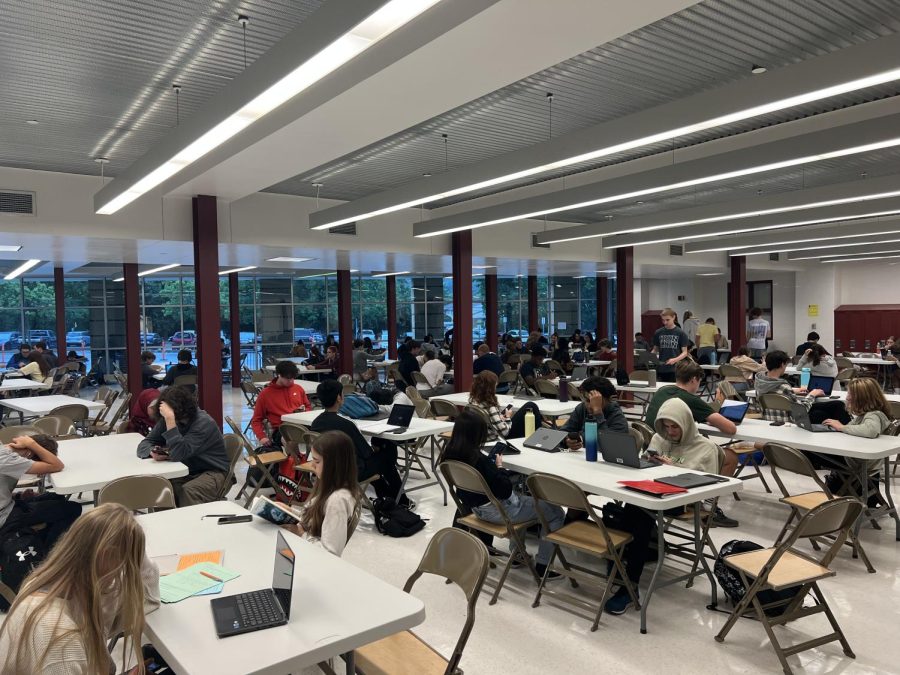New Faces, New Spaces: EHS brings changes
September 28, 2022
This previously ran in our September 2022 print issue.
As students enter the locker commons doors for the 2022-23 school year, they are greeted by a variety of changes to the Emmaus High School environment: new faces, new spaces, new schedules, and new policies among them.
Leading the charge of the new advancements is a new face herself: principal, Beth Guarriello. In her first year since joining the Emmaus community from Southern Lehigh High School, Guarriello has come with big plans for the new school year.
“What I’m most excited about is trying to bring the school back together…you only get one chance at high school,” she said.
One of the most talked about additions this school year comes within the bathrooms of EHS: vape detectors. The detectors can sense noises, vape smoke, and physical disruption with the device itself. Detectors alert administrators in these instances, in addition to when sound levels within the bathrooms exceed a certain decibel.
“The vape detectors are helping us funnel the kids to the appropriate services [Project Connect and/or the Karen Foundation],” Guarriello said.
Regardless of what type of alert goes off, an administrator and/or staff member will make their way to the restroom. All the students present in the bathroom are then subject to a search of their bags and any pockets on their clothing.
Jasmine Tiedeman, a senior, has mixed feelings about the addition of vape detectors.
“I get the precaution, [but] kids went from being nervous to go to the bathroom because of the vaping to being afraid because they might get searched,” Tiedeman said.
Changes to the school environment have been a big part of this year. The biggest change has been the addition of homeroom, a 30-minute block between 2nd and 3rd block every single day of the school year.
As students go through their four years of high school, they will keep the same teacher and classmates in homeroom year after year.
“So those relationships, that family, that community that you’ve built with the teacher with the majority of the students stays the same. And it’s consistent…I think that consistency is important,” Guarriello said.
Katerina Starry, a sophomore, shares this positive outlook on the addition of homerooms.
“I really enjoy my homeroom. It’s nice having some down time in the middle of the day,” Starry said.
These homerooms have changed every year: from traditional homeroom, to flex-block, to advisory, and now to Hornet Huddle.
The new homeroom plan provides the security of a “home-base” within the school and a constant throughout the years. Additionally, every Thursday a bonding activity is provided for every classroom.
Another unique part about homeroom is that it combines grade levels, four freshman, sophomores, juniors, and seniors. The point of this is to allow upperclassmen to serve as mentor-like figures for underclassmen.
These homerooms have shifted the bell schedule ever so slightly; none of the classes are the exact same length and the bells ring at different times than they ever have before.
This change has also affected how long student lunches are. Students have a total of 25 minutes to get to the cafeteria, purchase food, eat, and clean-up.
Student and building safety is the basis of multiple new building policies, recently introduced security measures being one of them. These changes include the locking of all classroom and entrance doors, the elimination of entrances and exits, and the no-work lunch plan.
Students are no longer able to go see a teacher or leave the cafeteria without explicit permission, a measure enacted to protect teacher lunch time as well as ensure that students actually ate their lunches.
Classroom doors remain locked at all times during class periods; teachers and administrators are the only approved individuals allowed to permit entrances into the classroom.
While outside doors being locked is nothing new, the practice of locking the inside doors has thrown many students out of their comfort zones.
Locking inside doors ensures that if a threat manages to get into the school building, they would not have free reign of the classrooms.
Tiedeman feels the locked doors are a disruption from the day.
“The teacher has to interrupt class to let you in,” Tiedman said.
Junior Kayla Gonzalez also finds issue with the locked doors.
“The doors make the rooms much hotter and make some students feel very uncomfortable,” she said.
This change in locking procedures has also changed how students can exit and enter the building. In the morning, for regular arrival, students must enter via the main office door, the auditorium door, or the HIVE doors – the same for regular time departures.
Late arrival students must enter the building via the auditorium doors and will be held until the bell rings in order to prohibit students from walking the hallways without a classroom to go to.
The main purpose of these new regulations is to ensure that students in the building are under the care of a specific teacher and not wandering or alone at any time. Additionally, this plan is in place to stop students from sneaking out of the building before they are allowed to leave.
“The adults are here not only [to] just teach students, but to ensure their safety. And so the adults should be the one monitoring who goes in and out [for] purely safety reasons,” Guarriello said.
As the school year settles into a pattern of normalcy, all students will have to re-adjust to their new environment.











